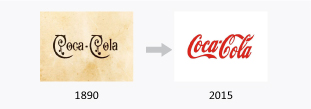
Instagram’s New Logo Is A Statement About Its Brand Narrative
By Shelby Fisk
“A business needs a character and an identity, just like a person. And just like a person it needs to have a voice.”
― David Amerland
From Apple to Google to Uber — major companies often face an onset of negative reactions after logo changes big and small. And with social media, negative opinions multiply faster than ever before. But it isn’t all a game of follow the leader; viscerally, we care when our favorite brands change.

Photo Source
For as long as logos have existed, updates have taken place. McDonald’s, Nintendo, and Starbuck’s original logos look nothing like the modern variations. And for established brands, changes, over time, seem inevitable. Occasionally, brands get it right the first time — establishing a timeless image.

Photo Source
The Coca-Cola script is, technically speaking, beyond old-fashioned. Yet it’s iconic, and in many ways has helped build the brand as a household name.

Photo Source
With changing trends, merging companies, geographical expansions, and company changes, new logos are often in order. Especially if sales are declining, or you no longer think your logo speaks to who you are, or whom your customers seek, an update is needed. When your narrative changes, a new logo is sometimes what is best for your business. So why do changes upset users?
“Consciously or not, we internalize the brands that we admire (and want to align ourselves with) as well as the brands that are a part of our daily lives,” said Karen Winterich, an associate professor of marketing at Pennsylvania State University. “In general, the stronger our associations with a brand, the more negatively we react when its logo changes.”
What brands often get wrong is a lack of explanation, or in rare instances a lack of understanding what a brand’s core audience wants. “With every redesign, then, a brand risks alienating its core audience, a group that — through the megaphone that is social media — can easily vocalize its displeasure.”
Parallel with its logo redesign, Instagram also began rolling out the new algorithmic feed, similar to that of Facebook, as opposed to the prior chronological one. Though not the most visually identifiable, it is in fact, the largest recent change to Instagram — and more impactful than its logo redesign.
When first announced, more than 300,000 Instagram users signed a petition asking the company to reconsider this change, fearing it will significantly reduce the organic reach that brands and influencers get on the platform.
“From a user perspective, however, I actually think this is beneficial. If done properly, the algorithm will reduce clutter on the feed and ensure more relevant and engaging content gets pushed to the front,” said Gil Eyal, CEO of influencer database and tracking firm, HYPR.
In any event, Eyal offered some advice for brands and influencers: “Look at your recent posts and see which have gotten the highest levels of engagement. These posts are the ones that are likely to perform best when measured by Instagram’s new algorithm. You want to make sure you identify the characteristics of these successful posts, so that Instagram recognizes your content and decides to promote it.”
The fate of every logo change depends upon the story a brand chooses to tell its audience prior to and after the update. Aside from color choices, or design, and whether you like the update or not, what Instagram chooses to say next matters most. Logos are what we see, what is behind them — brand stories, are why we care.
Shelby Fisk is a Manager at Woden. Whatever your storytelling needs may be, let Woden help. Download our free StoryBlueprint, or send us an email at connect@wodenworks.com to discuss how we can help tell your story.


